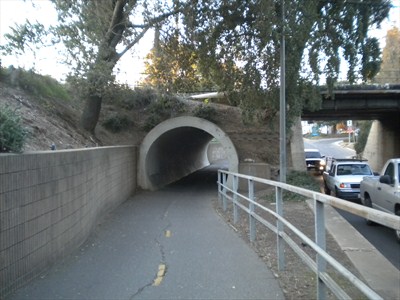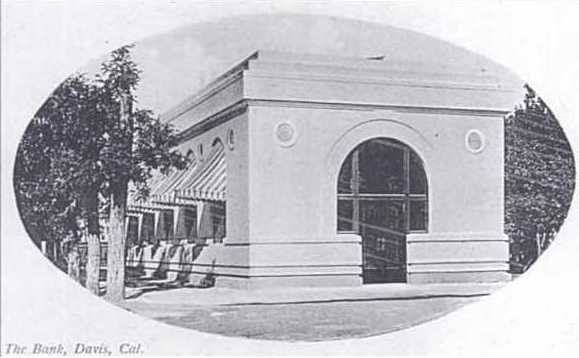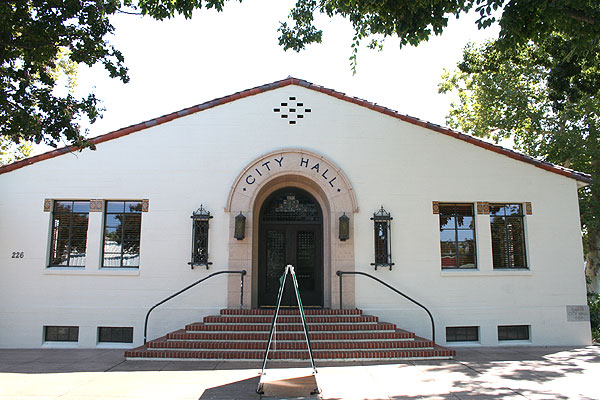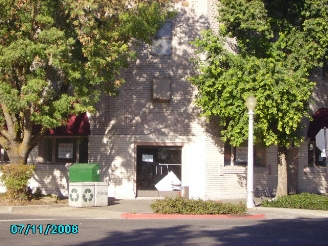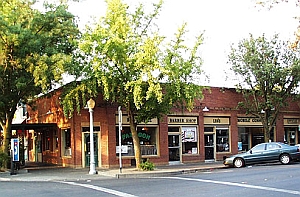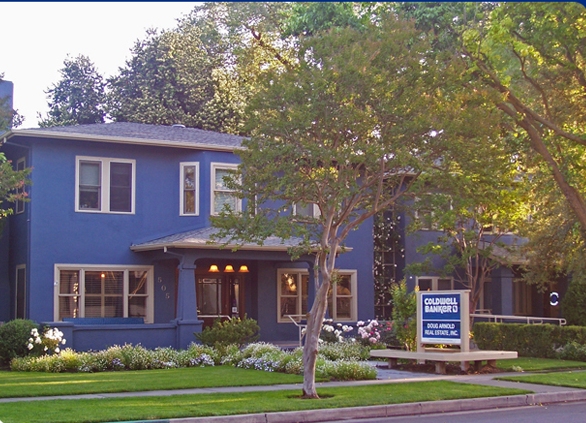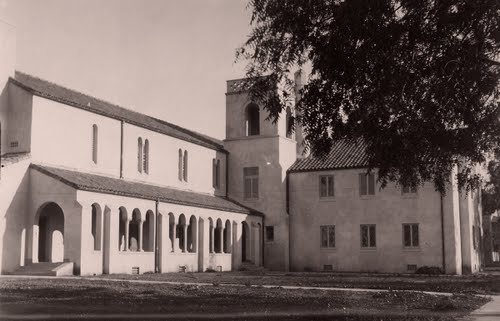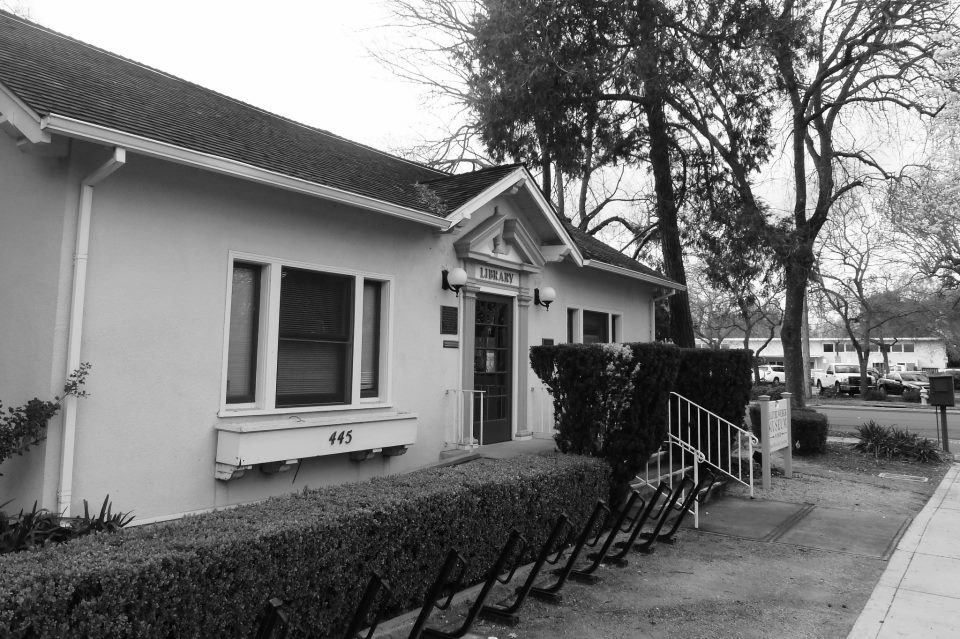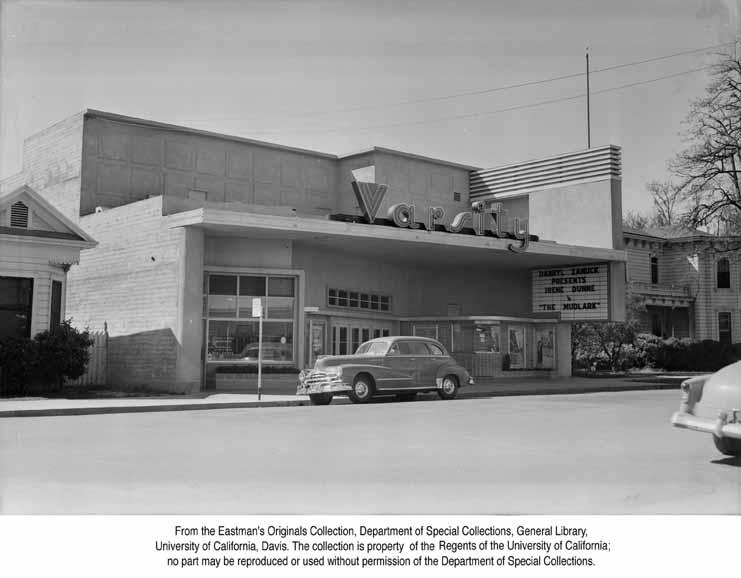Historical Properties in Downtown Davis
Downtown Davis has a long and rich history as the cultural and economic center in the City of Davis. Below are historical properties located in the downtown.
You may download this listing, with a brief history and map, by clicking HERE.
The Davis Arch (1916)
The Davis Arch, one of the most striking structures in early downtown Davis, no longer exists. It spanned 2nd Street at G, between buildings # 6 and # 7, welcoming visitors from the depot (# 8) and proclaiming “Davis” to be “Gateway to Yolo County” and “Home of the University Farm.” It was a symbol of civic pride and unity, having been built in 1916 following a suggestion from a State Farm student, but adopted as a project by The Woman’s Improvement Club in the absence of a local government to fund such an undertaking. Reportedly because the Arch proved hazardous to increasing automobile traffic, it was torn down after a relatively short life in 1924. (Larkey, Page 124, 126 and Lofland, Page 50, 74)

The Davis Enterprise, Circulation (Date Unknown)
303 B Street Another structure without Historical Resource designation is the building which currently serves as the Davis Enterprise Circulation Department. In addition to administering justice and publishing a newspaper, William Scott (See A above) operated several businesses from this location. These included an insurance agency, a real estate office, and a job printer. The building still stands today, although a board façade makes it barely recognizable. Photos of this early Davis Enterprise building, and of Scott, may be found in books on Davis history, including an interior shot (Larkey, Pg 109) and one with Scott and Floyd Gattrell, the first Davis Chief of Police (Larkey, Pg 78 and Lofland, Pg 79).
Judge William Scott Home (1916)
301 B Street This house, which currently houses the popular bakery Cicolat, is not a designated Historic Resource and is probably not significant structurally. It has definite historical significance, however, as it was the home of Judge William Scott and his wife Kathryn for many years. Both William and Kathryn were born to Yolo County farmers and in addition to serving as Justice of the Peace until 1942, Scott owned and published the Davis Enterprise from 1899 until 1935. His contribution to the development of Davisville/Davis was extensive. John Lofland says of Scott, “Over these almost 37 years, William Henry Scott was the Davis Enterprise,” and Lofland credits him with writing almost all the stories and reports (Lofland, Pg 34). Although official action was actually taken over a year later, it was Scott who initially dropped the “ville” from Davisville. “The Saturday, April 7, 1906 issue of Scott’s newspaper was called the Davisville Enterprise. But the next issue, Saturday, April 14, 1906, was the Davis Enterprise.” (Lofland, Pg 54). Lofland reminds readers that Davisville was announced as the site for the State Farm on Friday, April 6, and Scott did not think the “ville” carried the proper connotation for the town anymore, stating, “the ‘ville’ attached signifies a countryside place of insignificant import, and we believe it . . . . should be eliminated . . . . “ (Lofland, Pg 54). So it was
Masonic Lodge (1917)
221 - 225 G Street The present two story structure was formally dedicated in 1917, although the Masonic Lodge of Davis had been chartered in1873. An earlier Masonic Hall, located just south of this building, had burned in 1916, and prior to the construction of that building, local Masons had met in the Odd Fellows Hall. This is a typical American building type: a two story structure housing a fraternal society on the second floor, with the ground floor devoted to income producing commercial space. Many different small businesses have occupied the ground floor and the upstairs currently houses several offices, the Masons no longer involved in the building. Although not as visible today as in the early days because of mature trees, the Renaissance Revival building is one of the largest and most imposing of the historic commercial buildings on G Street. It joins with # 6, # 7 and # 10 as visible remnants of the historic Davis commercial district along “main street.” Like the other three, much of the ornamentation is achieved by the pattern of the brick work, although the end bays project slightly, implying towers, and terra-cotta rondels with the Masonic insignia in low relief are set in the upper portion of the these bays.
Clancy House (1913)
137 C Street This structurally impressive residence stands as a symbol of what could be accomplished “starting on a shoestring” by diligent and hard working immigrants in the early days of California. Mathew Clancy, an Irish immigrant who settled in Davisville in 1862, built this variation of Colonial Revival style house 51 years later in 1913. He worked for various local farmers and in 1873 leased 520 acres where he raised wheat and livestock. By 1896 his savings permitted the purchase of 160 acres in Solano County and he continued to rent other farms, including the land where the College Park section of Davis is now. He continued to increase his acreage, both owned and leased, and farmed until his death. (Larkey, Pg 156)
McDonald House (1894)
337 B Street Built in 1894, this Victorian cottage predates the establishment of the University Farm and the subdivision of the area into residential lots. It is an example of a simple Queen Anne and is one of two pre-20th century houses in what is now the University area, the other being the Eggleston house on 3rd (# 17). The structure was built by the McDonald family and when the area was subdivided for housing it was known as the McDonald subdivision. The house was purchased from the McDonalds by current Davis residents Scott and Leslie Gordon, who bought it in the 1970’s when they were first married and lived in it prior to a move to the Bay area.
Jacobson-Wilson House (1914)
232 B Street John Jacobson, a carpenter employed by the University, built this one story bungalow, which fuses the Craftsman with the Colonial Revival styles in 1914. He also built other houses in the neighborhood, mainly working for professors he met on campus. He lived in this house until 1919 when it was purchased by James Wilson, professor of Animal Husbandry at the University. The Wilson’s added the second story in 1923 and the building served as the Wilson family home for many years. In 1925, Professor Wilson became the first chair of the Davis Planning Commission and served in that capacity for 12 years. (Lofland, Pg 101, 106)
Greive/Asbill Home (1911)
310 A Street This modest one and a half story shingled Craftsman bungalow is significant because of its simple but fine design and because of its association with an early Davis family. It was built in 1911 by Albert N. Greive and his wife “Jakie” after coming to Davis in 1890 and opening a livery stable. In 1898, they built their first hotel which burned in 1906, and a second, the four story Buena Vista, also burned in 1918. Both hotels had served as important social centers and the Greives, especially Jakie, were heavily involved in community affairs. For example, at the time of the legislative action (1911) which banned alcohol in Davis due to its potentially negative impact on students, Governor Hiram Johnson held a special hearing on the issue, inviting both sides to speak. Jakie, owner of the Buena Vista Hotel with its bar, feeling betrayed after she and other saloon owners had vigorously supported the drive to bring the University Farm to Davisville, told the Governor that “residents would rather have the saloons than the farm if a choice had to be made between the two” (Lofland, Page 56). A daughter born in 1889, Vere Grieve Asbill, was also quite active in the community and in her youth played “mood music” for the first silent films shown in Davis. (Note: As is not uncommon in historical records, a lack of consistency exists relative to names of these parties. The Davis Register of Historic Places, the primary reference for these descriptions, refers to Jack Grieve and his wife “Jackie,” but in “Davisville ’68” (Larkey, Page 171), the reference is to Albert N. and his wife “Jakie”. Two spellings, Grieve and Greive, are also indicated in Davisville ’68.)
First Presbyterian Manse (1884)
619 4th Street This vernacular Classical Revival house was built in 1884 by William H. Hampton, owner of the Davisville Lumber Company and an elder and bookkeeper for the Davisville Presbyterian Church (Davis Community Church). It served as the first manse (pastor’s residence) of the church and the first occupant was Rev. J. E. Anderson. It was converted into a community center for students in 1924, but later sold to private owners and returned to residential use. In 1928 it was the home of Rev. Martin Fiske, pastor of the Davis Community Church from 1920 – 1933. Rev. Fiske was responsible for raising funds for the construction of the church building at 4th and C Streets (# 2) in 1926.
Montgomery House (1890)
923 3rd Street This modest one story vernacular house derives its significance from its early pioneer associations and its careful architectural design. The home was built and occupied by Andrew and Louisa Glocker Montgomery. Andrew was one of 14 children of an early Yolo farmer, Alexander Montgomery, who farmed a section of land where the Willowbank and Oakside subdivisions are now located. Louisa was the daughter of Charles Glocker, a German immigrant, who farmed 640 acres in the North Putah District. Their daughter, Marguerite, was a revered school teacher in Davis for whom the Marguerite Montgomery Elementary School is named. Located in one of Davis’ early residential areas, the house is a very fine example of the elegance which is sometimes achieved by the vernacular and is carefully proportioned with some exceptionally handsome details.
Eggleston Home (1870)
232 3rd Street This modest, one story, vernacular, wood frame house is significant because of its association with a member of the early Davisville community, Lucy Eggleston. She was active in community affairs, attended the Community Church regularly and was secretary of the Women’s Temperance Union for over twenty years. She is an example of how early Davisville residents maintained a close connection to farming even while living in town, as the area around her house was filled with almond trees and she harvested and hulled the almonds to help pay her taxes. A barn and windmill once stood on the property and she raised chickens and sold eggs in addition to her almond income. The house contributes to the streetscape and is one of the older homes in this part of town.

Baravetto Home and Tank House (1915)
209 & 209 ½ 2nd St Giovanni Baravetto, who built this house in 1915, immigrated from Italy at the turn of the century and worked in vineyards near Hollister before moving to Davis to work for the University Farm vineyards in 1911. This Craftsman Bungalow house and its associated tank house (which has been remodeled into a residence) served as the home of the Baravetto family until 1950 when it was sold as rental units. The house is a good example of a builder’s interpretation of the Craftsman home and is in an area of mixed housing styles and types, at the edge of a complex of early buildings.
A. J. Plant House (1910)
221 1st Street This one and a half story Colonial Revival house which has a gambrel roof, indicating an influence of Dutch Colonial prototypes, was built by Albert June Plant, an important figure in early Davisville. A businessman and Notary Public, Plant kept minutes for both the first Davisville Chamber of Commerce and the Chamber’s State Farm Promotion Committee. As secretary, he was directly responsible for the Chamber’s 1905 publication, “An Ideal Spot for a University Farm” which gave many reasons for selecting Davisville as the site of the university farm. Plant, son of early Davisville residents Louis and Sarah Plant, started the Plant Grain and Warehouse Company on what is now the corner of 4th & G. Although both he and his wife Mary Ellen died at an early age, their oldest daughter Lois continued to live and look after the two younger children in this house.
Davis Subway (1917)
Richards Underpass The Richards Boulevard Underpass is a concrete structure that carries railroad traffic over Richards Boulevard with a simple, industrial character. The load is carried by means of steel I-beams which rest on concrete abutments to support a wood plank floor on which three sets of tracks are laid. It was built in 1917 by the California Highway Commission as part of State Route 6, with the cost being born equally by the State and the SP Railroad Co. Although the materials in the floor and the ties, etc. have been replaced many 4 times, the structure possesses a high degree of integrity, location, materials, workmanship, design, feeling and association. In the context of highway construction in California, it appears to be one of the oldest surviving examples of the use of I-beam construction on a railroad grade separation and the oldest in association with the SP system in California. Most grade separation projects undertaken in the pioneer era of state highway construction have been destroyed by subsequent highway widening projects, a concept repeatedly defeated by Davis voters prior to its designation on the National Register. State Route 6 was replaced by US 40, and signs along the “Historic US Hwy 40” are now up, including the route through Davis. The route was also part of the Lincoln Highway for a time and concrete markers designate that route as well.
Schmeiser Home (1911)
334 I Street This impressive structure has elements from both Colonial Revival and Queen Anne styles. It was built in 1911 by Theodore G. Schmeiser who was born on his parents’ ranch west of Davisville in 1877 and established the Schmeiser Manufacturing Co. next to the railroad tracks in 1905, just blocks from his house. “TG,” as he was known, manufactured farm implements and either invented or improved a number of widely used agricultural mechanisms. In 1910 he organized the town’s first water company and he was a charter member of the Davisville Almond Growers Association. He and his wife were active in community affairs between 1900-1925 when the manufacturing plant was moved to Fresno and the Schmeisers divorced, she remaining in Davis. An innovative fire protection system was built into the house, consisting of a large cistern in the back yard, a water tank in the attic connected to water hoses on all floors and, at one time, a method for catching rain water on the roof.
Williams-Drummond Home (1876)
320 I Street This two story, symmetrical house is Italinate in styling and formal in feeling. It is significant not only because of its architectural qualities but also because of its early construction in one of the first extensions of Davisville and because of its association with John C. Drummond, a prominent Davisville farmer. W. S. Williams constructed this home in approximately 1876 on 3 lots he purchased from the Davisville Land Co., the original promoters of the Jerome C. Davis Ranch. Ownership was transferred to Drummond in 1880, who wanted a house in town so his children could attend Davisville schools. He had come to California in 1849 with his brother Lewis and worked as a blacksmith in Sacramento for 12 years, saving money to buy land. He bought 700 acres SE of Davisville in 1881 and became one of Davisville’s largest land holders, ranking high among Yolo County farmers.
Bank of Yolo (1910)
301 G Street This is an example of an important American architectural genre: the small-town classical revival bank. Although a small building, it establishes a massive scale through careful proportioning. The Davis branch of the Bank of Yolo opened in 1909 in a small wooden building located behind the present structure, which was completed in 1910. The bank served Davis in this building from 1910 to 1933 when it failed. Although it did not open its doors after the Crash, it repaid its depositors in full within a few years. After the Crash, the building housed other banking operations and also City of Davis offices (the flagpole on the roof is a carry-over from those civic days). It is currently occupied by a restaurant, the Noodle Express. It and the adjacent Davis Enterprise building are the northernmost remaining buildings in the historic Davis “main street” streetscape along the West side of what is now G Street. (Others are # 6, # 7 and # 24.)
Old Davis City Hall (1938)
226 F Street The building, a fine example of the Spanish Colonial Revival style, originally housed all city administrative offices and the Fire Department. The Davis City Hall no longer serves that function, hence the term “old” in its title. The Fire Department was first to move out in 1966 and that area was occupied by the Police Department. Since 1981, the “New City Hall” is the refurbished “Old Davis High School” on Russell Blvd. The “Old City Hall” continued to serve as the Police Station until 2001 when it moved to a totally new facility on 5th and Cantrill Drive. The Old City Hall has since been remodeled into a restaurant.
Southern Pacific Depot (1911)
2nd and H Streets In 1868, the California Pacific Railroad built a branch north from Davisville to Yuba City off its main line between Vallejo and Sacramento. This “Y Junction” greatly stimulated growth in Davisville. The original frame structure was replaced in 1913 by the present Mission Revival style structure, a superb representation of a building type important to the state’s development. With recent refurbishing of the depot itself, along with improvements to the parking lot and nearby structures, the 2nd and G Street intersection once again welcomes train and bus travelers to the City of Davis, even without the Davis Arch (see note above).
Anderson Bank Building (1914)
203 G Street John B. Anderson, who served as the first mayor of Davis in 1917, built this large brick building, which still dominates a corner opposite the railroad depot (# 8) in the central business district, in 1914. The direct simplicity of its style reflects influences of Louise H. Sullivan, a landmark American architect of the Prairie School. As with the brick building across the street (# 6), ornamentation is achieved primarily by relief modulations in the brick surface, although there are some terra cotta insets in this case. Original occupants included the newly organized Bank of Davis, with an entrance facing the corner (an entrance which is currently utilized but which was bricked over at one time when users of the building had other ideas); the Davis Post Office, located north of the bank and facing G Street; several businesses in ground floor shops along 2nd Street; and doctors, lawyers and dentists who leased office space on the second floor.
Brinley Block Building (1926)
714-726 2nd Street Built in two phases (1926 & 1928), the Brinley Block Building, a one story brick structure, is an example of commercial architecture of the late 1920’s. The building incorporates several business establishments into one clean overall rectangular design, with ornamentation primarily consisting of integral patterns in the brick. Although not as old as the Anderson Bank Building (# 7) and the Masonic Hall (# 24) it joins with them in contributing to the surviving but limited “downtown” streetscape. The building stands on the site of a former popular gathering place of the time, Weber’s Yolo Saloon (see photo in Lofland, Pg 71). The owner of the current building is a descendent of the Weber family.
Boy Scout Cabin (1927)
1st and F Streets The “Log Cabin” is an example of a continued fondness for the rustic forms and images of pioneer America. It is also an example of what community effort has accomplished in Davis. The community began looking for a place to house the growing range of scouting activities in 1924. The Rotary Club played a major role in fund raising, and construction of such a facility began in 1926. The “logs” of the cabin are actually electrical poles donated by P.G. & E. and members of the Rotary Club and other volunteers from the community, assisted by the Boy Scouts themselves who laid the foundation, constructed the building on land leased from the University. It was dedicated in December of 1927.
Dresbach Hunt-Boyer Mansion (1875)
604 2nd St This two story Stick-Italianate house is a superb example of the style and the most sophisticated and best preserved of its type in Davis. It was built in 1875 for William Dresbach, a prominent local merchant who was appointed Davisville’s first Postmaster, and the elegant 12 room house reflects the lifestyle of one of early Davisville’s wealthiest citizens. As Postmaster, he is credited with naming the town after Jerome C. Davis, although there is some debate about that. Before leaving Davisville for San Francisco in 1877, Dresbach owned a general store, a livery stable, a hotel and saloon, and a grain warehouse. The house, with an intact water tower and remnants of an orange grove, is located in a transition area between the downtown commercial district and remnants of the early residential area. It is one of the few remaining early mansions in the downtown area and currently houses City of Davis offices
H.J. Hamel Home (1920)
505 2nd Street This home, an example of the fusion of Colonial Revival and Craftsman elements, was built in 1920 by Henry Jacob Hamel and his wife Lida and served as the home for this prominent, early Davisville family for many years. Henry was the son of a German immigrant, Hartman Henry Hamel, who came to Davis in 1867. Hartman located his family on a 1200 acre ranch just south of Davisville in Solano County, which became the nucleus of a large scale cattle and farming operation. (The Werner/Hamel House**, built in 1859 on the Solano County site and purchased by Hartman in 1869, was eventually moved into Davis and is now located at 1140 Los Robles.) The home of Henry and his family is currently the office of Coldwell Banker Real Estate and the east end of the building and the handicapped access ramp are recent, business related additions.
Davis Community Church (1926)
412 C Street The only large-scale building built in the style of a Spanish Colonial structure in Davis, the church is a fine example of the best architectural achievements of the 1920’s. Not only is the structure significant, the basic landscaping makes its contribution, including the Cypress trees flanking the front entrance which have been grown from seeds brought from the Garden of Gethsemane. Initially the Davis Presbyterian Church and still affiliated with the Presbyterian Church, it was reorganized in 1925 to become interdenominational in character and renamed the Davis Community Church. Today, Davis Community Church is a Presbyterian Church (USA) congregation.
Hattie Weber Museum (1911)
445 C Street The first library building in Davis, the original one room structure was built after volunteer fundraising to purchase the lot on F Street. The Bachelor Girls, a social organization, raised the $550 for construction through dances, luncheons, spinning bees and parties. Hattie Weber, the first librarian, remained in charge for 43 years, and the building remained a library until 1968 when the present library on 14th Street opened. The building was enlarged in 1924 and again in 1959. It is a modest yet handsome example of the Colonial Revival. Following its use as a library, the building served as the Davis Teen Center. When it was moved to its present site in 1988, it opened as the Hattie Weber Museum. In addition to its use as a museum, the City owned building also serves as a public meeting room.
Varsity Theatre (1950)
616 2nd Street This is a superb example of a late Streamline Moderne movie palace with original neon signage. The building marks the end of the downtown commercial area and the beginning of an early residential neighborhood and is a prominent visual landmark. Built in 1950 by the West Side Valley Theaters, the Varsity Theater has become a Davis cultural institution and continues to provide Davis with entertainment, although now converted for live stage use. The theater was originally built in 1921 at 702 2nd Street by the Luft family in the hope it would earn income as a rental property. However, the managing company folded within a year and the family became directly involved in the entertainment business. Each family member was active in the variety of tasks needed, including playing the organ to accompany silent movies. Although it survived the Depression and increased entertainment competition, it was sold to the West Side Valley Theaters Company which later built the present theater, billed in 1950 as the most modern theater in the Sacramento Valley. It is currently owned by the City of Davis.

